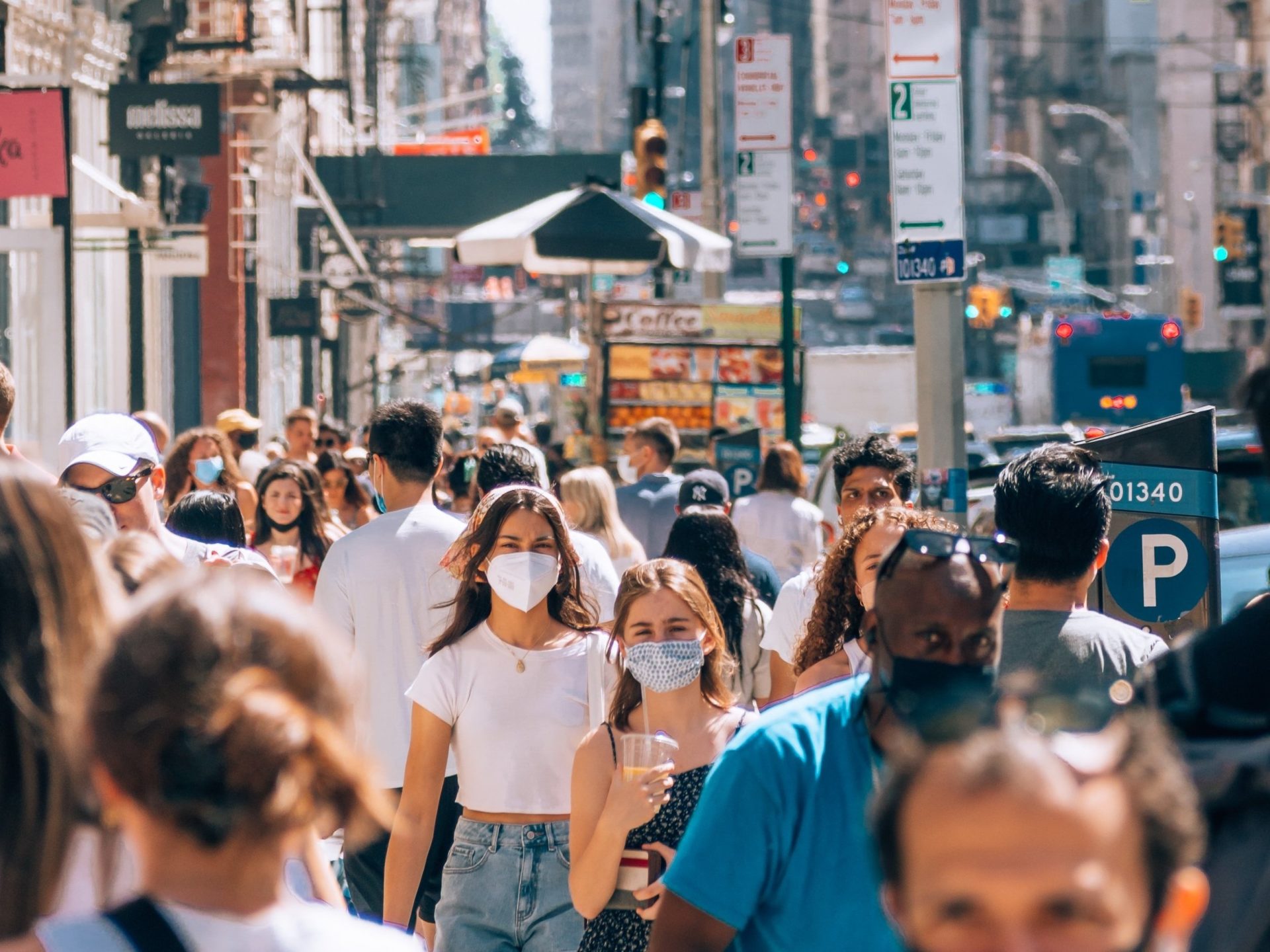
Now that the summer is here, it is easy to be bewitched into thinking that the pandemic is behind us and we can finally, at long last, return to some sense of normalcy. It is true that we have made significant process in reducing severe illness and death from COVID-19, but is the emergency phase of the pandemic really over?
First let’s look at the numbers. By the beginning of June, global daily confirmed deaths from COVID-19 were 90% less than their peak in the first pandemic winter starting at the end of 2020. They’re currently at the lowest level since we started tracking in March 2020. In the United States, daily deaths have remained at less than 350. Hospitalizations in the US are at 25,000 and trending up in a lot of states, but far from their peak of almost 155,000 during the Omicron surge this past winter.
The seven-day average of cases has plateaued at around 100,000 in recent weeks. This surge is driven by the highly contagious BA.2.12.1 Omicron subvariant that has risen to dominance. The official tally of cases is surely an undercount given the widespread availability of home-based rapid antigen testing. A recent article published in JAMA estimates the actual number of daily cases to be eight times higher. In a pre-print study, researchers demonstrated the prevalence of SARS-COV-2 to be approximately 22.1% during New York City’s BA.2/BA.2.12.1 surge in April and May of this year. This is 31 times higher than the official case count.
The higher actual number of cases brings into sharp focus the significance of decoupling case counts from hospitalizations and deaths. While case counts are still high, the level of hospitalizations and deaths remain low. This “defanging” of SARS-CoV-2 speaks to the wall of immunity we have built in this country via vaccination and, unfortunately, millions of infections.
This defanging is even more significant upon closer analysis of hospitalization data. In states like Massachusetts and across other health systems that track hospitalization in detail, there is a clear trend showing the majority of hospitalizations are for patients who incidentally test positive for COVID. A study from Southern California showed the same thing, that two-thirds of COVID hospitalizations at this point are among those who are testing positive but hospitalized for another reason. For those who are admitted for COVID-related illness, their hospital stay is shorter, and they are less likely to require intensive care.
This tracks with what we see on the front lines of the Emergency Department (ED) as well. Yes, the staff and resources of EDs and hospitals across the country are stretched. But not with sick COVID-19 patients. For example, the volume at the ED in Los Angeles where one of us (Dr. Daignault) works is back to high pre-pandemic levels. Patients are presenting with acute exacerbations of multiple chronic medical problems because they were unable to access their primary care doctors/specialists or get critical diagnostic tests or treatments during the pandemic. Emergency departments are now daily facing a backlog of patients who have waited for months for routine outpatient care. We rarely see patients sick with hypoxia from COVID-19 viral pneumonia, for example.
We are beginning to see traces of the BA.4/5 subvariant pop up in our genomic surveillance on the heels of BA.2.12.1. We have learned to tread carefully when thinking one country’s experience with a variant will be echoed here.
It does appear that countries with a significant prior BA.2 surge such as the UK were less likely to also experience a BA.4/5 surge. This is perhaps owing to antigenic similarities (including the L452Q mutation) between the subvariants which confers some cross-protection.
Nonetheless, SARS-CoV-2 has thrown us curveballs before. And although continued Omicron subvariant antigenic drift is more likely than antigenic shift to an entirely new variant, we don’t want to rely on vaccines alone to keep our death rates low, which is why the therapeutics for those at high risk for severe covid-19 illness – such as Paxlvoid and Molnupiravir – are so important.
Whether the emergency phase of the pandemic fades into the rearview mirror is entirely up to us. We certainly won’t end up back to square one, but that depends on how quickly we move to refine and update how we track disease severity, next-generation vaccines, and therapeutics.
Better Tracking of COVID’s Impact
Hospitalizations for COVID-19 are the most important metric of the impact of this virus at this phase of the pandemic. However, we need better tracking of COVID-19 disease severity at the hospital level. Despite our previous plea in this forum, most county public health programs do not provide specific data on hospitalizations, despite acknowledging that they internally track “for” vs “with” COVID-19 hospitalizations. In Los Angeles County for example, hospitalization data is given a single sentence at the end of the daily press release, without further delineation. This misclassification continues despite the Biden Administration’s plan in February 2022 to track hospitalizations with greater accuracy.
Local public health departments have many options available to them for reporting hospitalization data. At the most basic level, hospitalization data should be divided by “for” vs “with” COVID. That however could be tricky as it might not clear at the time of admission to the hospital from the ED, whether a patient’s acute exacerbation of a chronic medical problem is due to their positive COVID-19 test. Massachusetts has taken data reporting to the next level, tracking use of the steroid called dexamethasone as a surrogate for severe covid pneumonia and hypoxia. Patients who require dexamethasone need supplemental oxygen and are often treated in the ICU. COVID patients with hypoxia requiring steroid treatment would be easy to track and enable us to assess the severity of disease and hospital resource capacity more effectively.
Vaccines
We have been lucky that the vaccines outfitted with the “wild-type” spike have held their own against severe disease and hospitalization against the more immune evasiveness of Omicron and its subvariants. We have come to expect that neutralizing antibodies as the first line of defense against infection will wane over time, but not T-cells and memory B cells. A recent study in Cell showed that the Pfizer vaccine-induced T-cells respond to the Omicron variant with conserved polyfunctionality, meaning that the T cells generated by the vaccine continue to bind and help kill the Omicron variant, despite its heavily mutated spike protein.
Protection from severe disease remains strong in the vaccinated due the robust recall of both humoral and T-cell immunity with a breakthrough infection. And even as antibodies expectedly decline after either booster or breakthrough infection, memory B cells exhibit broad-spectrum adaptation to the variant to which they are exposed and quickly generate antigen-specific antibodies.
However, despite widespread availability, we come up significantly short relative to other countries in boosting our at-risk elderly populations. Although our hospitals were not as stretched to the breaking point during this past winter’s Omicron surge as they were previously, almost as many Americans over 65 died of COVID during the winter surge as died from last year’s Delta variant surge. Older Americans need boosting. Indeed, the high rates of boosting in South Korea among the country’s elderly during the BA1 surge provided important protection against hospitalizations and deaths.
A second booster has been available for those over 50 in the U.S. since the end of March, although most other countries have decided on an older age cut-off (such as 65, 70, or even 80 years old) for this dose. Waning does occur faster with this second booster – due to the deepening immune escape of the Omicron subvariants. However, even though neutralizing antibodies are expected to wane, each booster (or exposure) diversifies and broadens T cell responses to the virus and a booster shot will also expand the potency of B cells. Therefore, boosters are important for those at high-risk for severe covid illness, such as our elderly.
Moreover, millions of Americans have had breakthrough infections by this point and have been left in the dark as far as guidance for additional boosters. Infection after vaccination (i.e. hybrid immunity) provides stronger protection than vaccine alone; rather than showing our immune system the same wild type spike protein, it will have seen the entire Omicron virus, for example. This induces broad neutralizing antibodies against reinfection with other subvariants, mucosal IgA antibodies and resident T cells in our nose and mouth, and trains up T-cells. Multiple epidemiological and immunological studies show that a booster is not necessary for most people after a breakthrough infection. A breakthrough infection should be counted as a “booster.”
Taken all this into account, the U.S. Food & Drug Administration (FDA) has a full slate in June. Priority must be given to approval for a vaccine – both Moderna and Pfizer – for those under the age of five. Unfortunately, review was delayed by the rise of the Omicron variant and the need to assess for the safety and efficacy of a 3-dose series of the Pfizer vaccine in addition to the Moderna vaccine. If approved by the FDA, the CDC Advisory Committee on Immunization Practices’ will need to give guidance for the parents of the 75% of children and teens who have recovered from COVID-19 infection, in particular the 33% who got infected during the winter. We recommend that a recent infection be considered equivalent to one dose and that children should be optimized to receive their vaccines on an extended 8-week or longer interval schedule to maximize immunogenicity and effectiveness.
Furthermore, the U.S. is woefully behind other countries in expanding its vaccine arsenal. There is still a large segment of the population who remain hesitant about mRNA vaccines and have been waiting for a more traditional vaccine vehicle similar to that of DTaP vaccine (Diptheria, Tetanus, and Pertussis). The FDA advisory committee just approved the two-dose Novavax vaccine on the strength of its pre-Omicron data which showed vaccine efficacy to be 90.4% against any COVID-19 infection. Real-world analysis will likely show diminished effectiveness against the Omicron subvariant but doesn’t outweigh the importance of continually developing and expanding our vaccine options.
And perhaps most importantly, the FDA needs to determine the composition for the second generation of vaccines to prepare for a Fall/Winter surge. We will soon have clinical data on the efficacy of bivalent vaccines – doses that would include both the wild type of spike and that of Omicron BA.1. Moderna recently announced its bivalent Omicron booster generated 8-fold increase in neutralizing antibodies. We expect the efficacy against any infection to be higher than the current vaccine options, however it’ll unlikely exceed the 90%+ we achieved with the original vaccine trial data.
The most significant question is whether we can ever again achieve the high level of sterilizing immunity we achieved against the wild type of SARS-COV-2. Multiple nasal spray vaccines in development might hold the answer. While shots in the arm do a great job protecting us from severe illness with their vaccine-induced T-cells and memory B cells, they often can’t mount a fast enough mobilization of immune defenses to our throats and nasal passages when we are initially exposed to the virus. This is problematic in the face of the BA.2 subvariant, for example, which is more efficient at replicating in the upper airways than previous variants. But spraying our nose with a vaccine could station immune responses in our upper respiratory passages to stop the virus from ever entering our cells in the first place.
We will eventually need whole virus vaccines. Covaxin shows the immune system the entire virus in an inactivated form, which will elicit a broad immunologic response not only against the spike protein, but also other parts of the virus. The vaccine also elicits strong cellular immune responses against variants of concern, which is vital for the long-term protection of the vaccine. While the two mRNA vaccines we have in the US showed reduced vaccine effectiveness against Omicron (for mild disease) due to the fact that Omicron BA1 variant has 32 mutations across its spike protein that distinguish it from the ancestral strain, immune responses from the Covaxin vaccine continued to neutralize the Omicron variant. Hundreds of millions of doses of Covaxin have been administered in India and an ongoing trial in the US will eventually allow its approval here.
Therapeutics
With vaccines we were able to significantly bolster our defense against severe illness and death, even in the face of the highly immune evasive Omicron and its subvariants. With therapeutics such as oral antivirals and monoclonal antibody treatment, we can add another layer of protection and keep both high-risk vaccinated and unvaccinated people out of the hospital. The new challenge is ensuring that both the public and physicians are aware of these treatment options and their ease of access.
In initial study data, the oral anti-viral Paxlovid demonstrated nearly 90% effectiveness at preventing hospitalization in unvaccinated trial participants. We now have real-world data out of Israel showing a clear benefit for Paxlovid in those high-risk for severe COVID disease – vaccinated or not. Even against the more immune-evasive Omicron variant, in those over 65, there was an 81% reduction in death and 67% reduction in hospitalization.
There was no benefit in this study for Paxlovid in those 40-64 years, but additional studies with a larger sample size of participants in this age group are needed. Additional endpoints should also be studied for the younger cohort including whether Paxlovid (and Molnupiravir) can reduce the duration of symptoms or prevent household transmission. We also need to get to the bottom of the rare but significant “Paxlovid rebound” riddle and whether a longer dose is needed for some individuals or if the timing of the antiviral needs to be adjusted.
And what about for long COVID? While an exact cause of long COVID remains elusive, and vaccination is protective, one of the proposed mechanisms of long COVID is a high viral load. While the debate continues on what percentage of those who recover from an acute infection will go on to develop long COVID, if there’s a chance that expanding access to Paxlovid could reduce that risk, this needs to be studied.
The monoclonal antibody bebtelovimab also remains a powerful option to prevent severe disease and hospitalization in high-risk patients who otherwise can’t take Paxlovid due to potential drug-drug interactions. The FDA recently updated its fact sheet that bebtelovimab retains activity against BA.2.12.1 and its key spike L452Q mutation. As EDs across the country return to peak pre-pandemic volume from other illnesses, bebtelovimab is a powerful and rapidly administered medication (takes 30 seconds by intravenous push) to high-risk patients in the ER.
Molnupiravir has taken a backseat to Paxlovid as the oral antiviral du jour. It’s relegated as the third-line outpatient treatment for those at high-risk for severe covid illness. However, it has fewer drug-drug interactions than Paxlovid. While it’s a similar twice-daily 5-day course, Molnupiravir does not require the additional ritonavir booster. In addition, in a powerful subset analysis from the MOVE-OUT study, Molnupiravir demonstrated an 89% reduction in hospitalization or death in immunocompromised participants.
A large study showed that a primary vaccine series and booster was very effective for patients on immunosuppressant treatment with rheumatological disorders. But for those immunocompromised patients with solid organ transplants or on B cell-depleting therapies unable to mount a significant protective response from vaccination there is the long-acting dual-monoclonal antibody Evusheld. Tixagevimab co-packaged with cilgavimab given as pre-exposure prophylaxis can provide protection for upwards of six months to immunocompromised patients. Evusheld has retained activity against subvariants BA.4 and BA.5 as well.
The White House has significantly increased the supply of Paxlovid available at test-to-treat hubs, mainly pharmacies. Moreover, we have made tremendous progress overcoming the initial barriers to access – including physician comfortability with managing drug-drug interactions in their high-risk patients. For instance, the Infectious Disease Society of America created an excellent resource that identified only two major contraindicated medications with Paxlovid – Rivaroxaban and Salmeterol – and provides physician guidance to safely navigate the others.
We are facing a formidable foe in SARS-COV-2 as it continually cycles up a new Omicron subvariant. But we are also continuing to learn and adapt as well. Yes, we’ve been lucky that our original vaccine recipe has continued to hold up, but that will certainly run out with more Omicron antigenic drift and increased immune evasiveness.
As such, we’ll need to stay multiple steps ahead with updated vaccines for all age groups. More research is needed into expanding use of our powerful therapeutic options as well. A rational roadmap forward to COVID management will help heal divisiveness. Better tracking of hospitalization data at the local and national level will better inform our leaders and this transparency will help rebuild the public trust in public health.

Michael Daignault
Dr. Michael Daignault (@dr.daignault) is a board-certified emergency room physician at Providence Saint Joseph Medical Center in Burbank, California.

Monica Gandhi
Monica Gandhi MD, MPH is Professor of Medicine and Associate Division Chief (Clinical Operations/ Education) of the Division of HIV, Infectious Diseases, and Global Medicine at UCSF/ San Francisco General Hospital. She also serves as the Director of the UCSF Center for AIDS Research (CFAR) and the Medical director of the HIV Clinic at SFGH (“Ward 86”).






